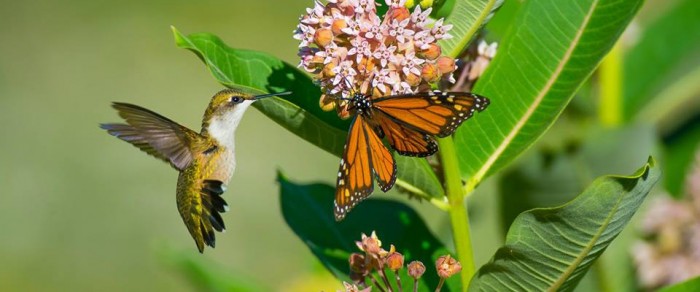
When they hear the word “pollinator”, most people automatically think, “bees!” While bees play an extremely important role in the pollination of plants, a pollinator is any insect or animal which moves pollen from one flower to the next. This includes bees, bats, butterflies, small mammals, moths, birds, flies, and beetles. Flowers are designed to attract pollinators with their vibrant colors and alluring fragrance, and in return the pollinators feed on the flowers' nectar and pollen.
Pollinators are vital to the endurance of many species of plants and animals- and that doesn’t exclude people. Roughly one-third of the food we eat is distributed by pollinators. Recently, however, populations of many of our favorite pollinators are in decline, partially due to loss of habitat and food.
Since it was recently National Pollinator Week, here are some ways to make your garden an inviting environment for all pollinators.
1. Plant a variety of flowers that bloom yearlong!
Because there is such a vast assortment of creatures that pollinate flowers, the best way to make your garden a welcoming place is to plant a wide variety of flowers that bloom throughout the year. Having a wide selection of flowers that bloom during each season will ensure that the different species, who are attracted to different flower types, do not go hungry.
For a list of perrenial plants, click here!
2. Plant a variety of color!
Similarly to how different people like different colors, different types of pollinators are also more attracted to different shades. You will draw more passing pollinators into your garden if you plant your pollinator-attracting perennials in a patch of 3-5 and plant big groups of similar colors together. This will more easily catch the eyes of pollinators.
- Bees are drawn to yellow, blue and purple. (Did you know? Bees see in a spectrum of light that's invisible to us- ultraviolet. Many flowers have ultraviolet markings on them called "nectar guides" which draw bees directly to the pollen and nectar of a flower.)
- Butterflies favor flat-topped "cluster" type flowers in red, orange, yellow, pink and blue.
- Hummingbirds adore tube or funnel shaped flowers in shades of orange, red, violet and pink.
3. Tempt with fragrance!
Scent is another thing that draws pollinators to flowers, so when planning your pollinator garden seek aromatic flowers. Herbs like sage, oregano, basil, and lavender contain many fragrant oils, so their flowers contain nectar which is particularly delightful to pollinators.
4. Know your natives!
When planning your pollinator paradise, take in mind the local species. There are approximately 500 species of bees and 175 species of butterflies that are native to North Carolina. Native pollinators are most attracted to the plants with which they co-evolved, so catering to their preferences will help you greatly. Native plants are also well adapted to our climate, making them a sustainable choice, which will be easier to preserve in the long run.
5. Provide a place to nest and rest!
Many species of bees are solitary, meaning they overwinter and nest in soil, sand or dead wood as opposed to hives. Large screening shrubs make a great shelter for all sorts of pollinators, and some of them, such as wild lilac and toyon, are good sources of pollen and nectar as well.
6. Make a bath available for birds, bees and, other pollinators!
Keeping a birdbath is a great way to attract a range of stunning songbirds to your garden, and it's especially valued in low-water years. You should also, however, find a spot in your pollinator garden for a bee & butterfly bath! Take a shallow tray, line with pebbles, and keep it filled with fresh, clean water. This provides water for smaller pollinators, especially butterflies who get a good deal of their essential minerals from drinking muddy water (an act known as puddling).
7. Learn to control pests naturally!
Integrated pest management (IPM) is a way of monitoring pests in your garden with less impact on the environment (the way to go!) Many pollinators also feed on insects like aphids, that's why upholding the equilibrium of beneficials and pests in the garden is imperative.
Happy gardening!